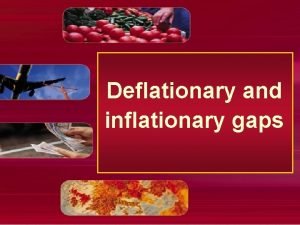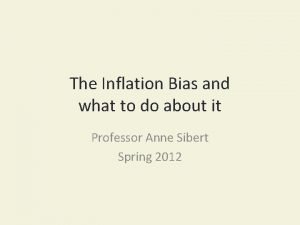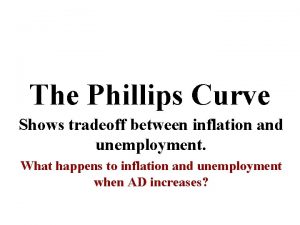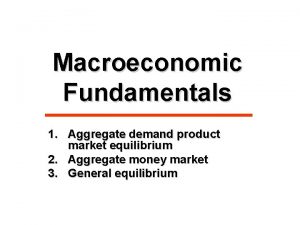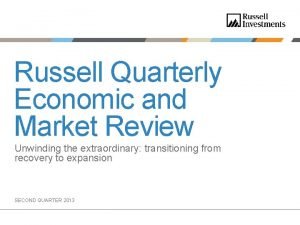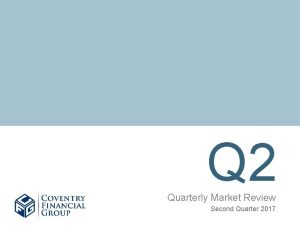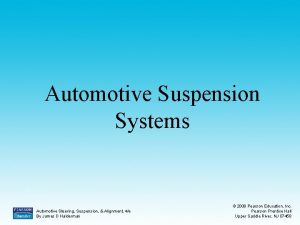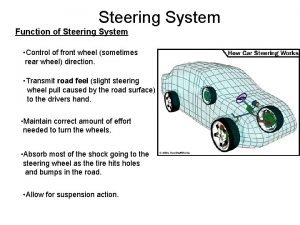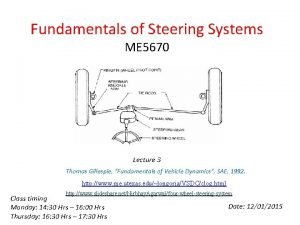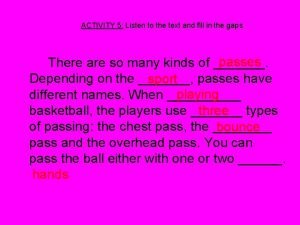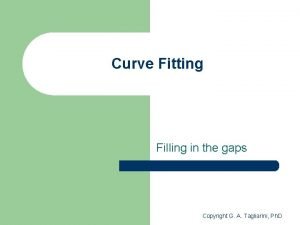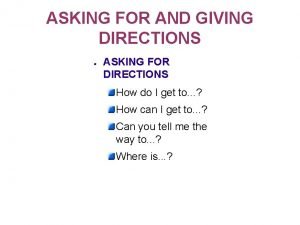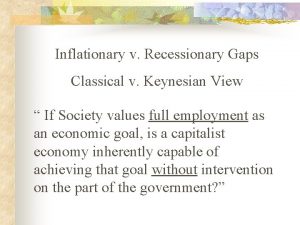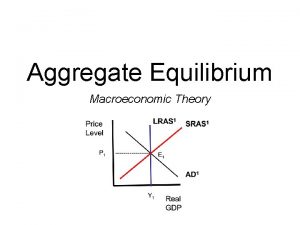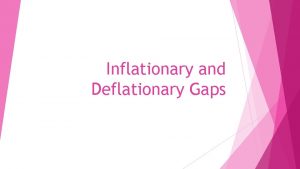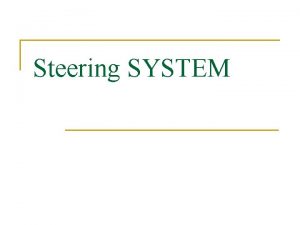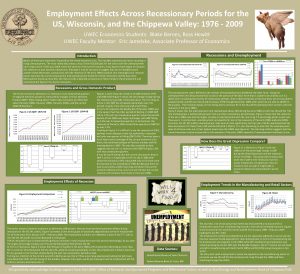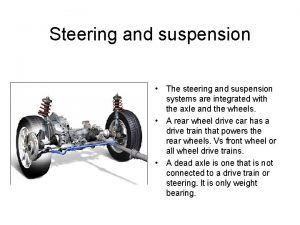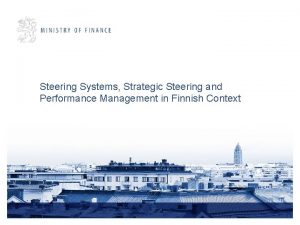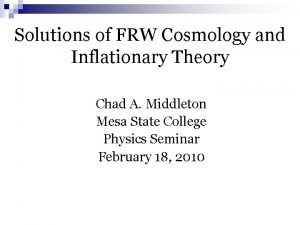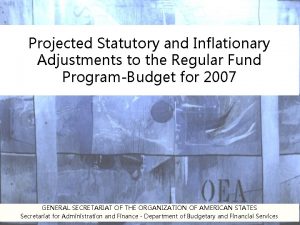Inflationary and Recessionary Gaps Steering the Market Economic

























- Slides: 25


Inflationary and Recessionary Gaps- Steering the Market Economic Activity Contraction (Recession 2 quarters of contraction) 1. GDP shrinks 2. Employment levels fall 3. Price level increases slow down of even fall Potential GDP (Full Employment) Expansion Time (years) 1. GDP grows 2. Employment rise 3. Price level increases faster


Topic Why are there Economic downturns? LRAS Solutions to Recession? How should the government carry out its economic role to accomplish the goals of full employments, increased production, and stable prices? Keynes Hayek

How should the government carry out its economic role to accomplish the goals of full employments, increased production, and stable prices? How would Keynes answer? How would Hayek answer? How would you answer?

The Aggregate Market- The Basics Long Run Aggregate Supply (LRAS) Aggregate- all together (total) Price Level Aggregate Supply (AS) Measure of Inflation The purpose of this graph is to look at countries. Total supply and demand at full employment Pe Aggregate Demand (AD) Qe G. D. P real Qy employment Qy= Quantity at full employment The law of demand is the same. There is an inverse relationship- PL up, AD down, PL down AD up The law of supply is the same There is a direct relationship- PL up, AS up, PL down AS down AD= Aggregate Demand AD= GDP= C + I + G + NX You may find it amazing how a graph can be interpreted in so many different ways. Learning the basics of the graph will provide you an opportunity to learn fiscal and monetary policy in different ways.

Why do we have Economic Downturns? According to Keynes. . . Because people follow their animal spirits (self-preservation). During economic downturns individuals save more, demand less, and spend less. (paradox of thrift) Workers refuse to accept lower wages and suppliers refuse to accept lower prices. (prices and wages are sticky). All of this results in lower Aggregate Demand, lower GDP, and lower employment. But not lower prices.

Hayek on Price. . . We all have bits and pieces of knowledge but there is nobody who knows everything. Real Prices convey realities and knowledge and serve as the best piece of information about the collective group. Prices serve to convey the collective wants of our society and the collective limitations. Price is the exchange for a good or service- determine by the supply and demand for the good Wage is the price of labor – determine by the supply and demand for labor Interest rates are the price to borrow money- determine by the natural supply and demand for loanable fund If prices and wages are allowed to function we should never stray far below or too far above full employment. If interest rates are natural we should never have over investments.

According to Hayek. . . Why do we have Economic Downturns? Recessions are natural and necessary for the economy to expand to cleanse itself. If the price mechanism is allowed to function the temporary set backs of recession will be offset by future gains and economic expansion in the long-run. When allowed to be, prices and wages are flexible and prices drop in both the product and resource markets. People’s savings increase loanable funds in banks and lowers interest rates. Companies can focus on long term investments. Interests coordinates savings and time. When interest rates are low there will be long term investments During expansion people spend more and save less- less loanable funds for business investments resulting in higher interest rates and short term investments that will result in quick paybacks. During contraction people save more and spend less- more loanable funds for business investments resulting in lower interest rates. This prompts business to create more lower order goods and less higher order goods. When these goods are higher level goods they consumer will be ready. During expansion if the Federal Reserve keeps interest rates artificially lower there will be an overuse of scarce resources caused by both by over consumption and over investment. People enter markets that they would not normally enter. Prices soar and the recession is worse than it would have otherwise been. There is higher risk of mal-investments. Recessions in the 20 th and 21 st century are worse because laws prevent prices from working and the federal reserve artificially lowers interest rates.

Recessions are natural Prices have meaning Whether they are prices, wages, or interest rates – they provide information Resources are scarce When the government manipulates prices, wages, or interest rates – it messes up the natural equilibrium of costs and benefits- spending isn’t free During the boom (expansion) government action results in overconsumption, mal-investments, misallocation of resources, and less predictability This makes the recessions much worse and much longer

What does the Long Run Aggregate Supply Curve look like? According to Keynes. . .

What does the Long Run Aggregate Supply Curve look like? According to Keynes. . .

What does the Long Run Aggregate Supply Curve look like? According to Hayek. . . People are motivated to keep their jobs. They will accept lower wages and prices will fall. They will either do this voluntarily or they will be forced to do it by looking for a new job.

Solutions? According to Keynes. . . Boost Aggregate Demand. Increase the C, I, or the G. Start spending now. The markets will not reach equilibrium not even in the long-run. In the long-run we are all dead. The money’s impact will multiply as more and more people spend. An upward spiral. Fiscal policy (Congress) to decrease taxes and increase spending. Deficit spending is acceptable. Monetary policy (the federal reserve) to lower interest rates and increase loanable funds. According to Keynes this will not impact price until full employment is reached.

Solutions? According to Hayek. . . Markets will reach equilibrium if price is allowed to function. Remove senseless regulations and taxes which prevent true growth. We produce so we can buy (Say’s law). When supply increases- prices will decrease which will increase demand. Capitalism is a profit and loss system don’t penalize people who do things right and don’t bailout those who waste resources. You cannot forget about people’s motivations and action. Thinking that you can simply fix the economy by spending and at the same time ignore human action and motivations is the Pretence of Knowledge.

Aggregate Supply – So what Model is correct? They Both have some valid points LRAS P. L. Classical Phase When in the Classical Phase The economy is operating at full employment Pe Any and all increase in AD will result in an increase in price and in increase in inflation Intermediate Phase Keynesian Phase AD AD AD Qy full G. D. P real When in the Keynesian Phase When in the Intermediate Phase Output can increase with no change in price. No increase in price level, no inflationary pressure, spare room to grow. As AD approaches the curve An increase in AD and decrease in unemployment Result in a gradual increase of price and some inflationary pressure

Price level



How should the government carry out its economic role to accomplish the goals of full employments, increased production, and stable prices? How would Keynes answer? How would Hayek answer? How would you answer?

Create Haikus- 3 lines 5 -7 -5 3 for Hayek and 3 for Keynes Each Haiku should have identifying concepts, make them informative but don’t include the person’s name. Please email me the haikus prior to the end of class and I will create a power point of some of the best Haikus. They will be used tomorrow as a review. The following are a couple of good examples.

Macro not Mirco Increase Government Spending Fiscal Policy Keynes

Flexibility Prices and Wages changing Equilibrium Hayek

Animal Spirits Confidence and Trust Creates Growth and Contraction Keynes

Equilibrium Real Production is Real Wealth Increase in Savings Hayek
 Recessionary gap
Recessionary gap Deflationary gap
Deflationary gap What is inflationary bias
What is inflationary bias Inflationary universe
Inflationary universe Phillips curve graph
Phillips curve graph Recessionary gap aggregate demand
Recessionary gap aggregate demand Ap macroeconomics graphs
Ap macroeconomics graphs The recessionary gdp gap represents the
The recessionary gdp gap represents the Positioning segmentation targeting
Positioning segmentation targeting Hypothetical market structure
Hypothetical market structure Economic development vs economic growth
Economic development vs economic growth Economic growth vs economic development
Economic growth vs economic development Economic systems lesson 2 our economic choices
Economic systems lesson 2 our economic choices Russell quarterly economic and market review
Russell quarterly economic and market review Russell quarterly economic and market review
Russell quarterly economic and market review Worm and sector steering gear
Worm and sector steering gear Chapter 4 drive right answers
Chapter 4 drive right answers Halderman
Halderman Function of steering mechanism
Function of steering mechanism Push pull.method
Push pull.method Vertical
Vertical Curriculum guide for driver education in virginia module 3
Curriculum guide for driver education in virginia module 3 Listen to text and fill in the gaps
Listen to text and fill in the gaps Complete the gaps with the past simple
Complete the gaps with the past simple Fills in gaps in data and fit data into curves
Fills in gaps in data and fit data into curves Dialogue asking for directions
Dialogue asking for directions

